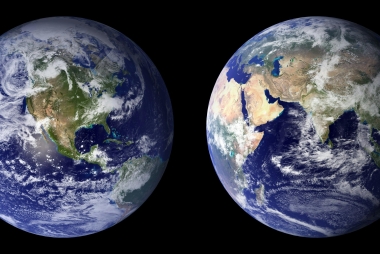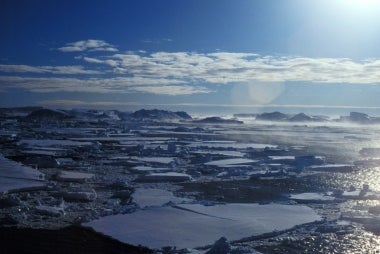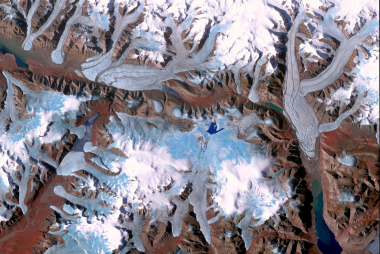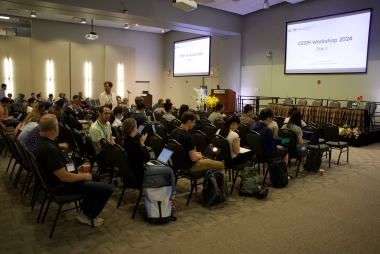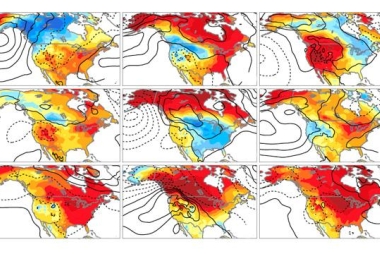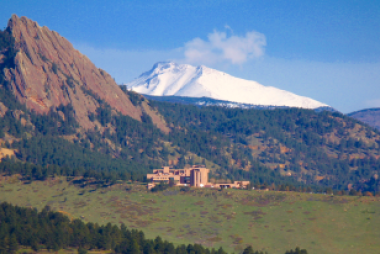September 2024 Newsletter Issue
Welcome to the Community Earth System Model (CESM) Newsletter. Want to receive our next newsletter in your inbox? Visit our newsletter page to subscribe and never miss a newsletter.
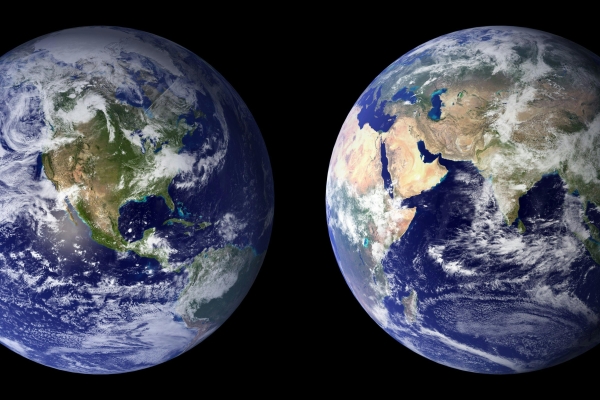
|
In this Newsletter:
Chief Scientist Message
Introducing the CESM3 Plans, Progress, and Timelines Page
Updates on the DiscussCESM Forum
CESM Tutorial at AGU
CESM Workshop and Tutorial Highlights
New CESM Co-Chairs
Upcoming Meetings
Research Highlights from our Community
Quick Links
Chief Scientist Message
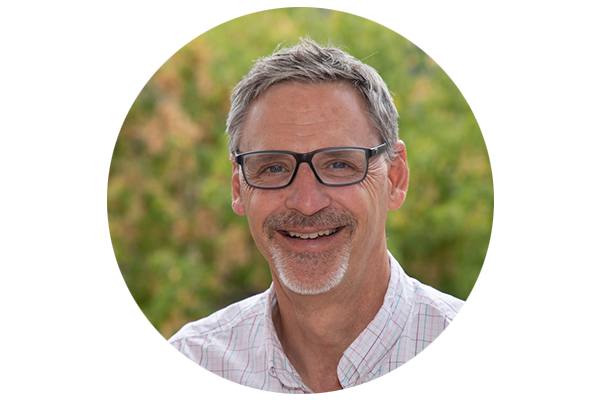
|
Dear colleagues,
Welcome to the September 2024 CESM Newsletter. The CESM3 development team has been hard at work over the summer. Scientific and software model development activities proceeded steadily and we have now successfully made it through to the other side of an August 31 deadline for a CESM3 scientific development code ‘chill.’ Over the next several months, we will be working through issues that we find in the coupled model test simulations, tuning component models and the coupled model, and ingesting and adjusting to new forcing data from CMIP. This is an exciting period as we progress towards producing and documenting a new model that we can release to the research community in 2025. To enable users to track what is coming with CESM3, we have put together a CESM3 Plans, Progress, and Timelines page where one can find the full list of implemented new model features and parameterizations and links to project planning and tracking pages, and estimates of computational costs of different CESM3 configurations to aid in proposal development.
Also in this issue are links to presentations from the annual CESM Workshop and the summer CESM Tutorial. The CESM Award winners were Jim Edwards for the Distinguished Achievement award for his long term foundational contributions to the CESM software infrastructure and Sam Mogen from the University of Colorado for the Graduate Student award for his work on ocean biogeochemical predictability. Congratulations to both! You will also find a fun CESM Tutorial limerick written (and performed at the tutorial) by Cecile Hannay. I hope you enjoy it as much as I did.
We highlight several interesting and diverse recently published studies that make innovative use of CESM including papers on (1) nudged atmosphere runs to evaluate errors in modeled sea ice responses to extreme circulation events, (2) the impact of Arctic halogen emissions on North America and Europe ozone concentrations, (3) the role of weather fronts in amplifying the atmospheric circulation response to Gulf Stream SSTs, and (4) the combined use of observed and CESM-modeled radiocarbon data that suggests that current models underestimate vegetation net primary productivity (NPP) and that plants store more carbon, but for a shorter time frame, than is currently recognized.
Looking ahead, we will be hosting a CESM tutorial at the AGU annual meeting as well as a town hall on simpler models and we are also looking forward to the Jerry Meehl symposium at the AMS annual meeting in January. We have identified dates, listed below, for the forthcoming series of CESM Winter Working Group meetings. Requests for presentations and registration information will follow later this fall, but please put the dates onto your calendar and we hope to see many of you there.
Lastly, I’d like to welcome four new Working Group co-chairs to the CESM leadership team. Gustavo Marques took over from Frank Bryan (Ocean Model Working Group), Alice DuVivier for Marika Holland (Polar Climate Working Group), Kristen Krumhardt for Matt Long (Biogeochemistry Working Group), and Mike Levy for Bill Sacks (Software Engineering Working Group).
Best,
Dave
CESM3 Plans, Progress, and Timeline page

|
We have put together a CESM3 Plans, Progress, and Timelines web page, accessible via the main CESM web page. Here, we included information on the science and infrastructure updates for the forthcoming CESM3 release. CESM3, which includes scientific advances in all components, is intended to be the model that is used for the CMIP7 DECK and Fast Track simulations and represents the collective effort of many scientists and software engineers from across the community. Here, you can find a full list of new model features and parameterizations and links to project planning and tracking pages, as well as estimates of computational costs of different CESM3 configurations to aid in proposal development. We will strive to keep this page updated as we get closer to the release.
The DiscussCESM Forum

|
We'd like to thank everyone for participating in the CESM community through the DiscussCESM Forum. For the year to date, there have been over 750 threads, 4000 posts, and 1700 users! The DiscussCESM Forum is a great way to get help with using the model or understanding model output. We strongly prefer that users utilize the forum to ask questions, rather than contacting NCAR staff directly, because questions answered in the forum are visible for everyone to see and therefore provide a wider benefit. In fact, if you contact an NCAR staff member directly with a forum-like question, it is highly likely that they will point you to the forum anyway.
Here, we alert users to two new forum features:
- New threads will start with a template that asks for specific information about the model version, configuration, machine, changes that you made, etc that will aid CESM staff in answering the question. See here for help with information to include help requests.
- The default for new threads will be "Question", which provides a few additional benefits:
- Arrows are provided for up-voting (or down-voting) an answer.
- The user who posted the initial question, or forum moderators, can mark a given answer as the solution; this solution will appear directly below the question.
- Posts in the thread can be sorted by votes.
- Threads with a selected solution will show up with a green check mark in the list of threads.
Note that when creating a new thread, you can alternatively choose to make it a "Discussion" thread, rather than a "Question" thread (using the tabs at the top of the post) if that is more relevant. We hope these new capabilities will make the forum even more useful.
CESM Tutorial at AGU
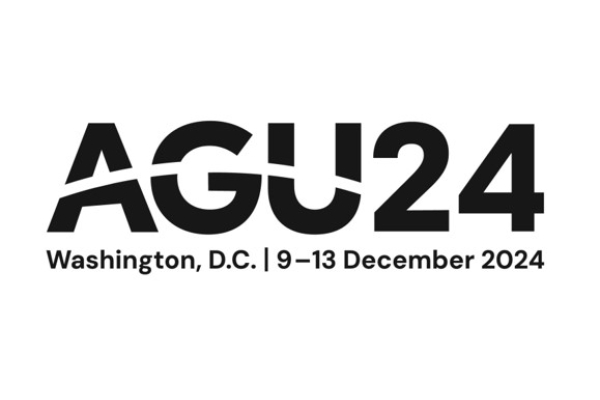
|
CESM Workshop and Tutorial Highlights

|
CESM Workshop
The 2024 CESM Workshop took place from June 10th to June 13th, 2024 in Boulder, CO. The event was a huge success with 255 in-person participants and 300 remote participants. If you missed any of the workshop, our online agenda has presentation slides. Additionally, you can watch the entire workshop on our YouTube channel.
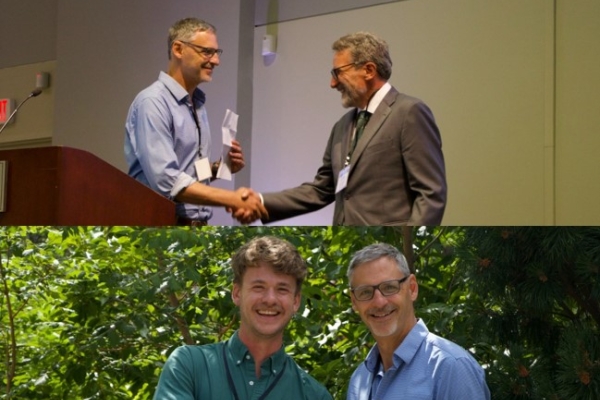
|
There were two award winners at the workshop. The CESM Distinguished Achievement Award went to Jim Edwards and the CESM Graduate Student Award went to Samuel Mogen. Congrats to both of our award winners and thank you for your contributions to CESM!
Distinguished Achievement Award: Jim’s contributions to CESM are so vast and integral to its success that it’s hard to imagine how the model would exist, in any form, without his contributions. His accomplishments are myriad, but they include over thirty thousand contributions to its code, porting of CESM to dozens of systems around the world, and tuning compsets for efficiency and performance. Much of CESM’s core infrastructure traces to Jim - he’s been a primary designer and developer behind the coupling infrastructure, ParallelIO, and a number of workflow tools, including the CESM-CYLC workflow used in the CMIP6 & SMYLE experiments. He’s also been central to other large ensemble efforts such as the LENS2 and S2S capabilities. As if that’s not enough, Jim also sits at the forefront of enabling new capabilities in the model, such as high-resolution efforts, novel architectures, Python AI/ML capabilities, lossy compression and more. In short, Jim is the rising software engineering tide that lifts all boats - his work underpins every aspect of CESM, and I think it is fair to say that there isn’t a single researcher using CESM that has not benefited from the foundational excellence that he has brought to the model, or his unwavering commitment to the long-term success of the project.
Graduate Student Award: Sam Mogen is a graduate student at the University of Colorado. He was recognized for his contributions to research on seasonal-to-multiyear prediction using the CESM prediction ensembles in collaboration with researchers in the Earth System Prediction and Biogeochemistry Working Groups. In particular, his work has contributed to fundamental advancements in our understanding of ocean biogeochemical predictability. This work has direct actionable science implications and, for example, is particularly relevant for marine resource management.
The pictures above are some of the photos featured in our online photo gallery. We additionally had an online poster gallery on our CESM workshop website this year.
CESM Tutorial

|
The 2024 CESM Tutorial took place from August 5th to 9th at the NSF NCAR Mesa Lab, CO. Participants came from 13 different countries all over the world for this tutorial. The CESM Tutorial consisted of lectures on simulating the climate system, practical sessions on running CESM, modifying components, and analyzing data, small group discussions with CESM scientists, and student networking. It provided attendees with a solid scientific understanding of the CESM components and the basic building blocks to start running the model. Keep an eye on the website for the 2025 CESM Tutorial application to open in early December.
If you missed any of the CESM Tutorial you can view it on YouTube. Similar to the CESM Workshop, on our website you can find presentation slides on our online agenda, lab materials from the tutorial , and an online photo gallery.

|
New CESM Co-Chairs
Welcome to our new CESM Working Group Co-chairs who took over this spring, and many thanks to our previous chairs for their years of leadership and contributions.
Biogeochemistry Working Group: Kristen Krumhardt took over for Matt Long
Ocean Model Working Group: Gustavo Marques took over from Frank Bryan
Polar Climate Working Group: Alice DuVivier took over for Marika Holland
Software Engineering Working Group: Mike Levy took over for Bill Sacks
Upcoming Meetings
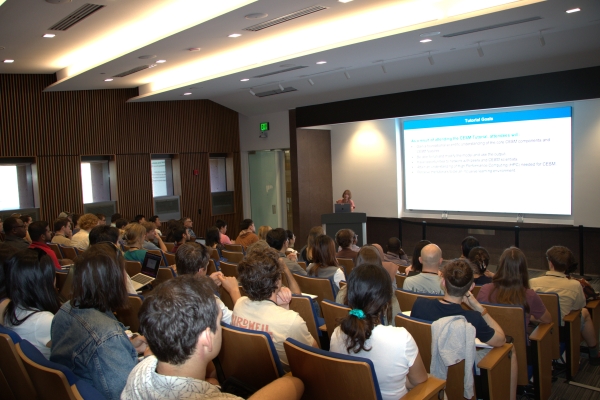
Caption
CESM Tutorial Lecture |
The 2025 CESM Winter Working Group Meetings will take place from January 28th to March 7th, 2025. The schedule can be found below:
Land Ice Working Group Meeting: Tuesday, January 28th
Paleoclimate Working Group Meeting: Wednesday, January 29th
Software Engineering Working Group Meeting: Thursday, January 30th
Atmosphere Model, Chemistry Climate, Whole Atmosphere, Earth System Prediction and Climate Variability and Change Working Group Meeting: February 3rd to 6th
Land Model and Biogeochemistry Working Group Meeting: February 24th to 26th
Ocean Model Working Group: February 27th to 28th
Polar Climate Working Group: March 3rd to 5th
More information to come on the webpage soon, including the Call for Talks and Registration forms.
Research Highlights from Our Community
Model Biases in Simulating Extreme Sea Ice Loss Associated With the Record January 2022 Arctic Cyclone
Blanchard-Wrigglesworth et. al (2024) used CESM1 and nudged it to the observed winds of January 2022, replicating the record Arctic cyclone of January 2022. This wintertime event caused a record loss in sea ice area as a result of strong ocean mixing and resulting heat loss to the sea ice, which underwent dramatic melt. They found that the nudged CESM simulations, despite having similar surface winds to reanalyses estimates, simulates much weaker sea ice loss than observed. The lack of response in CESM was due to negligible ocean mixing because the Arctic Ocean was too strongly stratified within the model. These results using CESM highlight the importance of ocean mean climate state in simulating realistic coupled atmosphere-sea ice interactions on a weather timescale. This work was published in JGR-Oceans in August 2024.

Caption
Figure 3: Change in sea ice thickness (SIT, m) from 21 to 27 January in CESM-Nudge simulations (left and middle columns) and observations (top right panel). The sea ice edge on January 24, defined as the 15% sea ice concentration contour, is shown by the magenta contour.
|
Natural Halogens emitted from Arctic sea-ice reduce surface ozone in North America and Europe
An international study lead by Rafael Fernandez (Fernandez et al., 2024) used the short-lived halogen version of CAM-Chem to show that Arctic sea-ice halogen emissions, such as chlorine, bromine and iodine, can cause frequent ozone depletion events in the mid-latitudes of the Northern Hemisphere during spring. Arctic halogen-rich and ozone-poor air-masses are exported southward, reducing background ozone over North America and Europe. Coupled halogen cycles drive the springtime ozone depletion over the Arctic and beyond, with bromine and iodine dominating the enhanced halogen-driven photochemical loss. The work highlights the importance of considering Arctic halogens in global models to properly capture long-standing observations of ozone seasonality over the Arctic. This paper was published in the Proceedings of the National Academy of Sciences in September 2024.
Variations in the ocean surface temperature (SST) influence the atmospheric circulation and thus climate over land. The canonical understanding is that tropical SSTs are typically considerably more important than SSTs in midlatitudes for predicting land conditions. However, this understanding is based on climate models that don't resolve processes at scales less than 100 km. In this study, Wills et al. (2024) show, utilizing variable resolution CESM2 simulations with 14km regional refinement over the North Atlantic, that by increasing the atmospheric model resolution to resolve features on smaller scales, such as weather fronts, there is a larger atmospheric circulation response to midlatitude SST anomalies in the North Atlantic. North Atlantic SST anomalies can be predicted multiple years in advance, and a larger atmospheric circulation response to these predictable SST anomalies therefore implies increased predictability of climate over the surrounding land regions. This study was published in the Journal of Advances in Modeling Earth Systems in July 2024.
Bomb radiocarbon evidence for strong global carbon uptake and turnover in terrestrial vegetation
Graven et al. (2024) use a budgeting approach to diagnose radiocarbon accumulation in the terrestrial biosphere caused by bomb testing to evaluate carbon cycling in terrestrial biosphere models. Graven et al. found that in CESM2 and CLM5 (land-only), NPP during the bomb spike (1960s) is significantly lower than the observed radiocarbon accumulation constraint implies. By developing emulators of , they were able to establish that virtually all CMIP6 models underestimate the radiocarbon accumulation in vegetation biomass. The reconstructed bomb spike radiocarbon vegetation uptake, combined with constraints on present day carbon stocks and productivity trends, indicates that the bomb-spike era NPP predicted by models (43 to 76 PgC) is considerably lower than the 80PgC estimated from observed constraints. These results imply that the storage of anthropogenic carbon in terrestrial vegetation is likely more short-lived and vulnerable than previously predicted and therefore that plants store more carbon but for a shorter time frame than is currently recognized. This paper was published in Science in June 2024.

|
Figure 1. Budget of excess 14C from nuclear bomb testing.
Quick Links
CGD X Account
CGD Youtube Channel
CESM User Support Forum
CVCWG Simulations
Simpler Models Information
Thanks for reading this CESM Newsletter! Expect to see the next one in the Winter of 2025. Please send potential Newsletter items to Elizabeth Faircloth.
